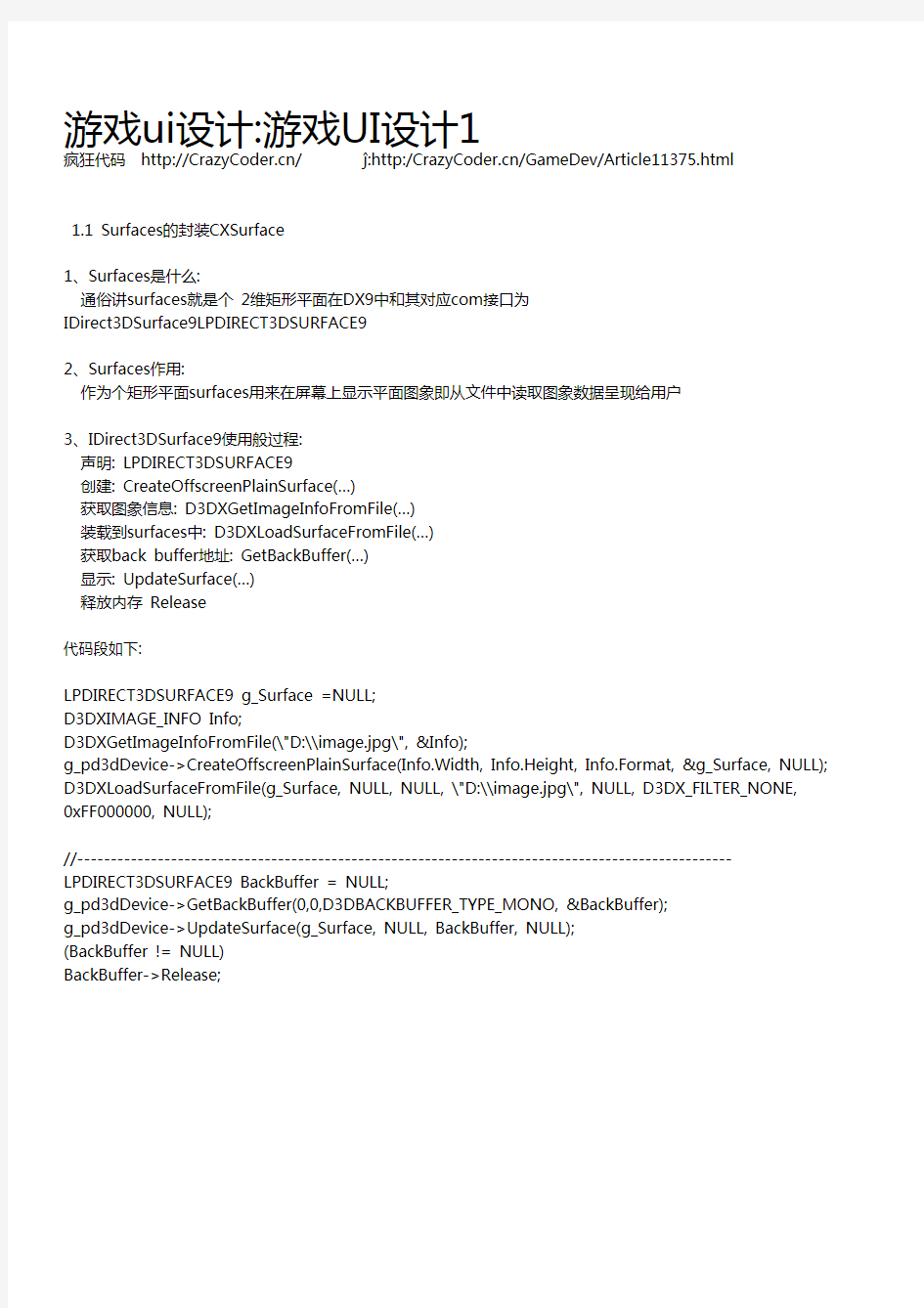

游戏ui设计:游戏UI设计1
疯狂代码 https://www.doczj.com/doc/87221272.html,/ ?:http:/https://www.doczj.com/doc/87221272.html,/GameDev/Article11375.html
1.1 Surfaces的封装CXSurface
1、Surfaces是什么:
通俗讲surfaces就是个 2维矩形平面在DX9中和其对应com接口为
IDirect3DSurface9LPDIRECT3DSURFACE9
2、Surfaces作用:
作为个矩形平面surfaces用来在屏幕上显示平面图象即从文件中读取图象数据呈现给用户
3、IDirect3DSurface9使用般过程:
声明: LPDIRECT3DSURFACE9
创建: CreateOffscreenPlainSurface(…)
获取图象信息: D3DXGetImageInfoFromFile(…)
装载到surfaces中: D3DXLoadSurfaceFromFile(…)
获取back buffer地址: GetBackBuffer(…)
显示: UpdateSurface(…)
释放内存 Release
代码段如下:
LPDIRECT3DSURFACE9 g_Surface =NULL;
D3DXIMAGE_INFO Info;
D3DXGetImageInfoFromFile(\"D:\\image.jpg\", &Info);
g_pd3dDevice->CreateOffscreenPlainSurface(Info.Width, Info.Height, Info.Format, &g_Surface, NULL); D3DXLoadSurfaceFromFile(g_Surface, NULL, NULL, \"D:\\image.jpg\", NULL, D3DX_FILTER_NONE,
0xFF000000, NULL);
//-------------------------------------------------------------------------------------------------- LPDIRECT3DSURFACE9 BackBuffer = NULL;
g_pd3dDevice->GetBackBuffer(0,0,D3DBACKBUFFER_TYPE_MONO, &BackBuffer);
g_pd3dDevice->UpdateSurface(g_Surface, NULL, BackBuffer, NULL);
(BackBuffer != NULL)
BackBuffer->Release;
//---------------------------------------------------------------------------------------------------
(g_Surface!= NULL)
g_Surface ->Release;
由上述过程可以看到IDirect3DSurface9使用虽然不十分复杂但有点不方便 ——创建和释放总要成对出现使用过程中还穿插着LPDIRECT3DDEVICE9接口这些若用个类封装起来使用就要方便多
4、如何封装:
按照surfaces功能创建它就用来显示图象因此要有读取图象接口和显示图象接口又要和
LPDIRECT3DDEVICE9设备接口关联因此需要个设置设备接口如下所示:
1、声明及释放
声明: LPDIRECT3DSURFACE9
释放内存 Release
2、关联图像:LoadFromFile
获取图象信息: D3DXGetImageInfoFromFile(…)
创建: CreateOffscreenPlainSurface(…)
装载到surfaces中: D3DXLoadSurfaceFromFile(…)
3、显示图象 Render
获取缓存Cache地址: GetBackBuffer(…)
显示: UpdateSurface(…)
4、关联设备接口 SetDevice
所以CXSurface定义如下:
CXSurface
{
protected:
LPDIRECT3DSURFACE9 m_Surface;
LPDIRECT3DSURFACE9 m_BackBuffer; //Back buffer
LPDIRECT3DDEVICE9 m_pDevice; //Direct3D设备指针
public:
CXSurface(LPDIRECT3DDEVICE9 pDevice);
~CXSurface;
HRESULT LoadFromFile(LPCSTR Path);
void Render(void);
};
1.2 Textures & Sprite 的封装CXTexture & CXSprite
1、何为Textures
Textures是在屏幕上显示平面图形它能够提供比 surface 更多图形处理效果——移动、缩放、旋转及作为纹理皮肤粘贴在3D模型上在Direct3D中其封装接口为IDirect3DTexture9
2、何为Sprite
IDirect3DTexture9能从文件中读取纹理数据但由于Textures不能直接复制到 back buffer因此在屏幕上绘制Textures的前需要另个接口——ID3DXSprite(精灵)ID3DXSprite能够把若干个Textures 复制给back buffer因此需要ID3DXSprite个例子就可以绘制所有纹理
所以IDirect3DTexture9用来存放所需纹理但它本身又不能绘制纹理需要借助接口ID3DXSprite
3、IDirect3DTexture9和ID3DXSprite使用过程
定义:~
创建:D3DXCreateTextureFromFile
D3DXCreateSprite
创建变换矩阵: D3DXMatrixTransformation2D
变换: SetTransform
绘制图象: Draw
释放内存: ~
代码如下:
D3DXCreateTextureFromFile(g_pd3dDevice, \"c:\\\\image.bmp”, &g_Texture);
D3DXCreateSprite(g_pd3dDevice, &g_Sprite);
//--------------------------------------------------------------------------
D3DXVECTOR2 Translation;
Translation.x = 500;
Translation.y = 500;
D3DXVECTOR2 Scaling;
Scaling.x = 1.0;f
Scaling.y = 1.0f;
D3DXMATRIX Mat;
D3DXMatrixTransformation2D(&Mat, NULL, 0, &Scaling, NULL, 0, &Translation);
g_Sprite->Begin(0);
g_Sprite->SetTransform(&
g_Sprite->Draw(g_Texture,
g_Sprite->End;
4、 如何封装
从以上基本过程可以看到CXTexture需要完成功能:提供和LPDIRECT3DDEVICE9接口和纹理文件文件关联对纹理进行处理(缩放、旋转……)
CXTexture
{
protected:
LPDIRECT3DTEXTURE9 m_Texture;
LPDIRECT3DDEVICE9 m_pDevice;
D3DXVECTOR2 m_RotationCenter;
D3DXVECTOR2 m_Translation;
D3DXVECTOR2 m_Scaling;
FLOAT m_Rotation;
RECT m_SrcRect;
public:
CXTexture(LPDIRECT3DDEVICE9 pDevice);
~CXTexture;
LPDIRECT3DTEXTURE9 GetTexture const { m_Texture;}
void SetTexture(LPDIRECT3DTEXTURE9 Texture) const {m_Texture = Texture;}
LPDIRECT3DDEVICE9 GetDevice const { m_pDevice;}
void SetDevice(LPDIRECT3DDEVICE9 pDevice) const {m_pDevice = pDevice;}
D3DXVECTOR2 GetRotationCenter const { m_RotationCenter;}
void SetRotationCenter(D3DXVECTOR2 RotationCenter) {m_RotationCenter = RotationCenter;}
D3DXVECTOR2 GetTranslation const { m_Translation;}
void SetTranslation (D3DXVECTOR2 Translation) const {m_Translation = Translation;}
D3DXVECTOR2 GetScaling const { m_Scaling;}
void SetScaling(D3DXVECTOR2 Scaling) const {m_Scaling = Scaling;}
FLOAT GetRotation const { m_Rotation;}
void SetRotation (FLOAT Rotation) const {m_Rotation = Rotation;}
RECT GetRect const { m_SrcRect;}
void SetRect(RECT SrcRect) const {m_SrcRect = SrcRect;}
HRESULT LoadFromFile(char* Path);
};
CXSprite主要功能就是在屏幕上显示 CXTexture因此需要有和 LPDIRECT3DDEVICE9 接口和 CXTexture连接
CXSprite
{
protected:
LPD3DXSPRITE m_Sprite;
LPDIRECT3DDEVICE9 m_pDevice;
public:
CXSprite (LPDIRECT3DDEVICE9 pDevice);
~CXSprite ;
LPD3DXSPRITE GetSprite const { m_Sprite;}
void SetSprite(LPD3DXSPRITE Sprite) const {m_Sprite = Sprite;}
LPDIRECT3DDEVICE9 GetDevice const { m_pDevice;}
void SetDevice(LPDIRECT3DDEVICE9 pDevice) const {m_pDevice = pDevice;}
HRESULT DrawTexture(CXTexture* Texture);
};
1.3 Keyboard & Mouse的封装CXKeyboard & CXMouse
1、何为Keyboard & Mouse
“地球人都知道”DX9提供接口 IDirectInputDevice8
2、 2者功能
Keyboard:读取键盘按键信息
Mouse:读取鼠标按键、位置信息设置光标属性(如用图片表示光标)
3、使用过程
创建 IDirectInput8 对象 DirectInput8Create
创建 IDirectInput8 设备(键盘、鼠标等) CreateDevice
设置设备属性 SetCooperativeLevel
SetDataFormat
获取设备使用权 Acquire
读取设备传入数据 GetDeviceState
释放设备及 IDirectInput8 Release
设置鼠标光标过程:
创建光标图片资源: 参照surfaces
设置光标为指定图片 SetCursorProperties
设置光标位置 SetCursorPosition
显示光标 ShowCursor
段如下:
LPDIRECTINPUT8 g_lpDI;
LPDIRECTINPUTDEVICE8 g_Keyboard;
LPDIRECTINPUTDEVICE8 g_Mouse
//
HRESULT Result = DirectInput8Create(g_hInst, DIRECTINPUT_VERSION, IID_IDirectInput8, (void**)&g_lpDI, NULL);
(SUCCEEDED(Result))
{
//创建键盘设备
Result = g_lpDI->CreateDevice(GUID_SysKeyboard, &g_lpDIDevice, NULL);
(SUCCEEDED(Result))
{
g_lpDIDevice->SetCooperativeLevel(g_hWnd, DISCL_FOREGROUND | DISCL_NONEXCLUSIVE);
g_lpDIDevice->SetDataFormat(&c_dfDIKeyboard);
}
}
//-------------------------------------------------------------------------------------------
//获取按键信息
(SUCCEEDED(g_Keyboard->Acquire)) //Acquire the device
{
char KeyState[256];
g_Keyboard->GetDeviceState((KeyState),(LPVOID)&KeyState);
//根据KeyState返回数据就可以判断按下何键
}
//
//创建鼠标
g_lpDI->CreateDevice(GUID_SysMouse, &g_Mouse, NULL);
g_Mouse->SetDataFormat(&c_dfDIMouse);
g_Mouse->SetCooperativeLevel(g_hWnd, DISCL_EXCLUSIVE | DISCL_FOREGROUND);
//------------------------------------------------------------------------
//设置鼠标光标
//获取光标图片
D3DXIMAGE_INFO ImageInfo;
D3DXGetImageInfoFromFile(\"C:\\\\Cursor.jpg”, &ImageInfo);
g_pd3dDevice->CreateOffscreenPlainSurface(ImageInfo.Width, ImageInfo.Height, ImageInfo.Format, D3DPOOL_DEFAULT, &g_MouseCursor, NULL);
D3DXLoadSurfaceFromFile(g_MouseCursor, NULL, NULL, (\"C:\\\\Cursor.jpg”, NULL,
D3DX_FILTER_NONE, 0xFF000000, NULL);
//设置成指定光标
g_pd3dDevice->SetCursorProperties(0,0, g_MouseCursor);
//初试位置
g_pd3dDevice->SetCursorPosition(0,0,D3DCURSOR_IMMEDIATE_UPDATE);
//显示光标
g_pd3dDevice->ShowCursor(true);
//------------------------------------------------------------------------- //获取鼠标信息
(SUCCEEDED(g_Mouse->Acquire))
{
DIMOUSESTATE State;
g_Mouse->GetDeviceState((DIMOUSESTATE),(LPVOID)&State);
//信息保存在 State中
}
//
//释放设备
(g_lpDI != NULL)
g_lpDI->Release;
4、封装
CXKeyboard封装
CXKeyboard
{
private:
LPDIRECTINPUTDEVICE8 m_pDevice;
char m_KeyState[256];
public:
CXKeyboard (LPDIRECTINPUT8 pInput, HWND hWnd);
~ CXKeyboard;
bool IsKeyPressed( Key);
HRESULT Update;
};
CXMouseSurface封装
为了能制作出动画效果光标因此需要个surfaces列表因此从CXSurface继承个CXMouseSurface类使的能够操作多个图片
CXMouseSurface : public CXSurface
{
private:
CXMouseSurface* m_pNext;
MouseSurfaceType;
UINT HotSpotX;
UINT HotSpotY;
public:
CXMouseSurface* GetNext { m_pNext;}
void SetNext(CXMouseSurface* Surf) {m_pNext = Surf;}
GetSurfaceType { MouseSurfaceType;}
void SetSurfaceType( Type) {MouseSurfaceType = Type;}
UINT GetHotSpotX { HotSpotX;}
UINT GetHotSpotY { HotSpotY;}
void SetHotSpotX (UINT X) {HotSpotX = X;}
void SetHotSpotY (UINT Y) {HotSpotY = Y;}
CXMouseSurface(LPDIRECT3DDEVICE9 pDevice) : CXSurface(pDevice) {m_pNext = NULL;} CXMouseSurface : CXSurface {m_pNext = NULL;}
};
CXMouse封装
CXMouse
{
private:
CXMouseSurface* m_Surface; //指向光标列表
CXMouseSurface* m_CurrentCursorSurface; //当前光标
LPDIRECTINPUTDEVICE8 m_pDevice;
LPDIRECT3DDEVICE9 m_p3DDevice;
DIMOUSESTATE m_State;
LONG m_iX;
LONG m_iY;
public:
CXMouse (LPDIRECT3DDEVICE9 pDevice, LPDIRECTINPUT8 pInput, HWND hWnd, bool Exclusive); ~ CXMouse;
HRESULT Update;
LONG GetXPos;
LONG GetYPos;
bool IsButtonPressed( Button);
HRESULT SetCursorImage;
HRESULT SetMouseCursor(char* FilePath, UINT HotSpotX, UINT HotSpotY, Type);
void AddCursorSurface(CXMouseSurface* Surface);
CXMouseSurface* GetFirstSurface { m_Surface;}
bool SetCursor( Type);
CXMouseSurface* GetCurrentCursor { m_CurrentCursorSurface;}
void SetCurrentCursor(CXMouseSurface* Surface) {m_CurrentCursorSurface = Surface;}
void SetCursorPosition( X, Y);
HRESULT SetCursorVisible(bool Show);
};
2009-2-12 5:24:35
疯狂代码 https://www.doczj.com/doc/87221272.html,/